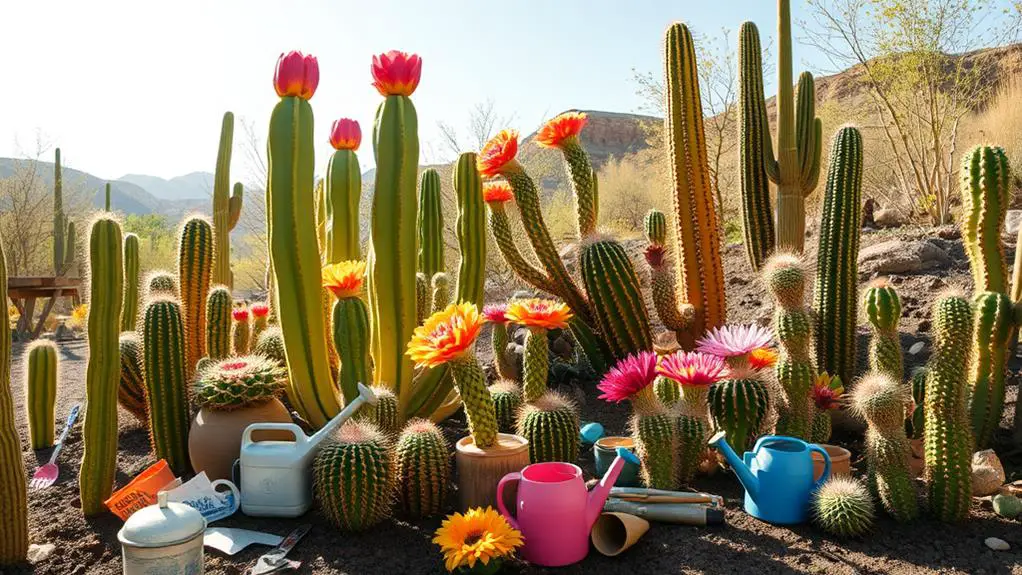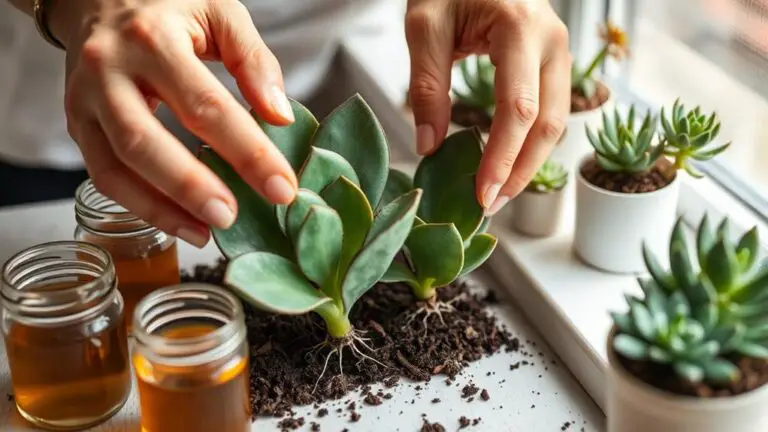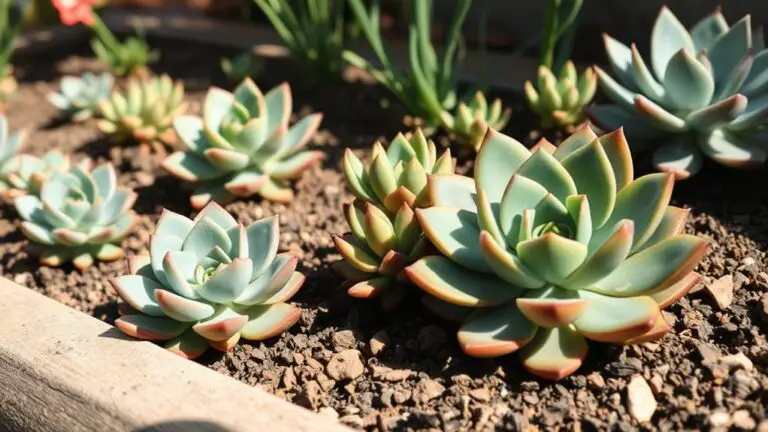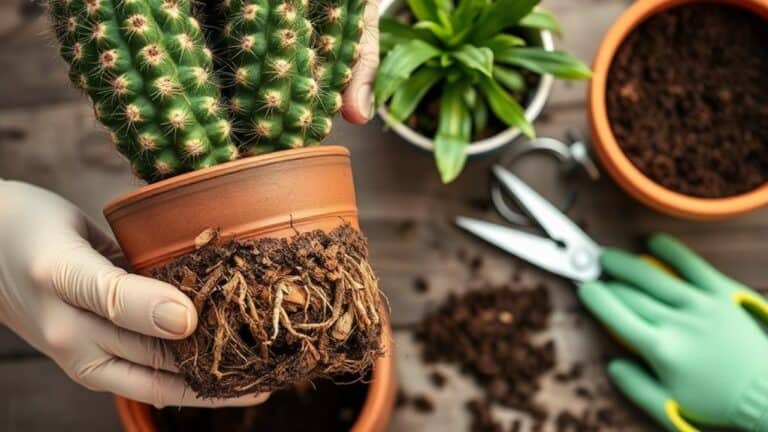Top 10 Most Common Cactus Care Questions Answered
You've probably wondered how often you should water your cactus or what kind of light it needs to thrive. Understanding these basics is essential, but there's more to cactus care than meets the eye. From selecting the right soil to recognizing signs of overwatering, each aspect plays a role in your cactus's health. How do you handle common pests or decide on the best fertilization schedule? The answers to these questions can make all the difference, and you'll want to get them right to keep your cactus flourishing. Curious about the specifics? Let's explore.
How Often to Water

Watering your cactus correctly is vital to its health and vigor. Cacti need just the right amount of water, and understanding when to water them can make all the difference. You should water your cactus only when the top 2-3 inches of soil are completely dry. This can vary, usually every 10-14 days in the summer and every 3-4 weeks in the winter.
Overwatering is a common mistake and can lead to root rot, which is why it's important to verify the soil is dry before watering again. Different species of cacti can tolerate drought to varying degrees, so the frequency might also depend on the specific type you have.
Containers with drainage holes are vital because they prevent water from accumulating, which can cause serious health problems for your cactus. If you notice wrinkles near the base of your cactus, it may be dehydrated and in need of a soak-watering.
Best Light Conditions

Guaranteeing your cactus gets the best light conditions is essential for its health and growth. Cacti need bright sunlight to thrive, ideally requiring 4-6 hours of direct exposure daily. This light helps them grow strong and healthy, and even encourages flowering.
A south or west-facing window is the best placement for your cactus, as these spots get the most consistent sunlight throughout the day.
If your cactus doesn't get enough light, you might notice it stretching or growing weak. This is a sign it's not receiving the energy it needs. To avoid this, make certain to position your cactus where it can soak up plenty of bright sunlight.
However, not all cacti are the same. Forest cacti, like the Christmas cactus, prefer filtered sunlight. For these, you might need to adjust their light exposure, especially with changing seasons.
It's also a good idea to regularly rotate your cacti. This guarantees they get even light exposure and prevents uneven growth patterns.
Ideal Soil Types
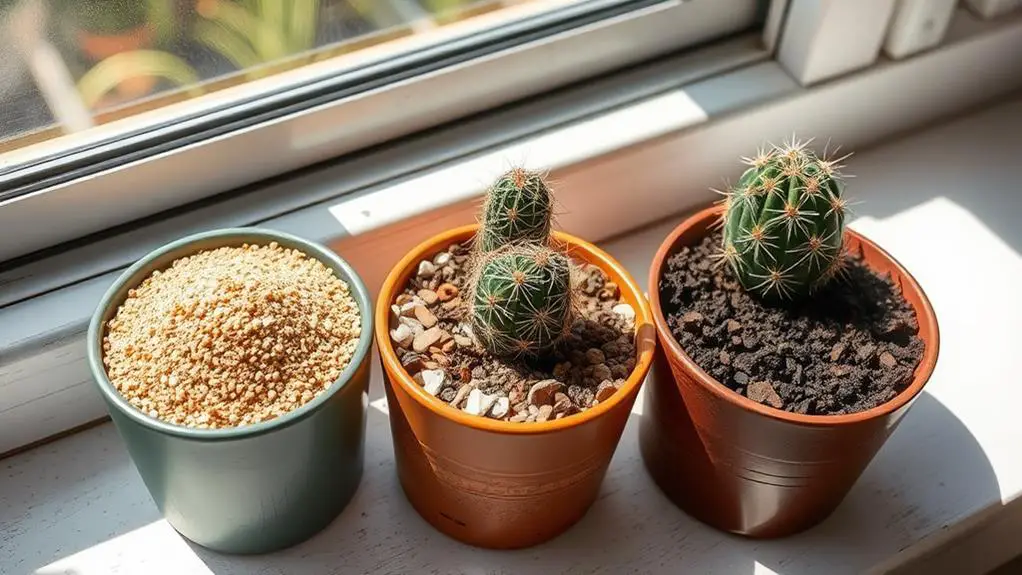
Choosing the right soil for your cactus is crucial to its overall health and longevity. Cacti need well-draining soil to prevent root rot. The best way to achieve this is by using a cactus mix, which you can find at most garden centers. These mixes are specifically designed to provide the ideal soil types cacti thrive in.
If you prefer a DIY approach, you can create your own blend. Start with half potting soil, then add half sand or grit. This combination guarantees good drainage and helps avoid overwatering issues, which are common with regular potting soil.
Regular potting soil retains too much moisture, leading to root rot and other problems.
Another critical factor is the pH level of the soil. Aim for a pH between 6.0 and 7.0 to keep your cactus happy and healthy.
Repotting your cactus every 2-3 years is also a good practice. It refreshes the soil nutrients and keeps the soil composition just right for your cactus type.
Common Pests
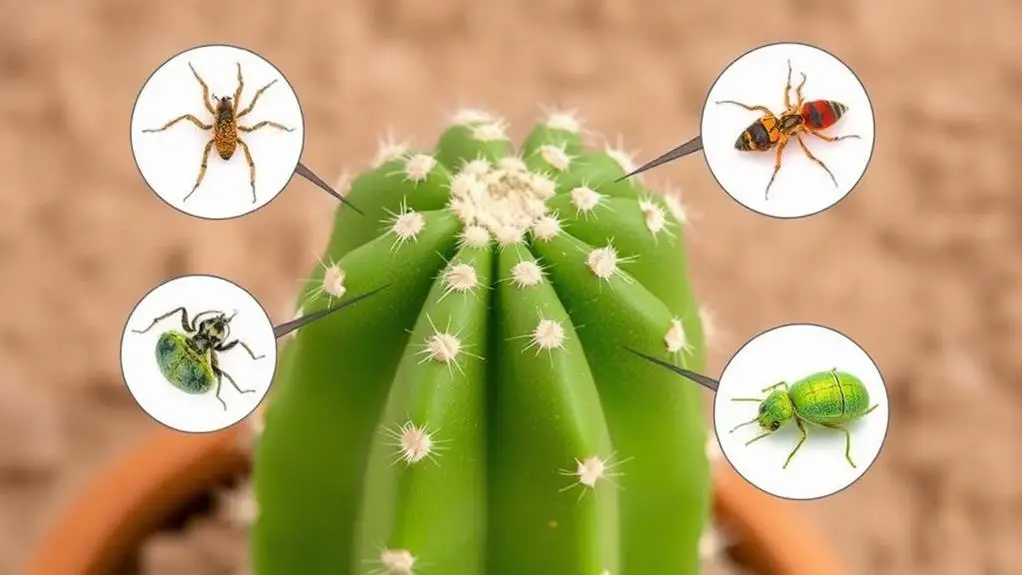
Dealing with common pests is an essential aspect of cactus care that shouldn't be overlooked. Pests like spider mites, mealybugs, and scale can cause discoloration and stunted growth in your cacti.
It's vital to inspect your cacti regularly to catch these pests early and prevent infestations from worsening.
To manage these common pests effectively, follow these steps:
- Regular Inspections: Check your cacti often for signs of pests. Look for small, moving dots (spider mites), white, cotton-like masses (mealybugs), or hard, brown bumps (scale).
- Keep Soil Dry: Overly wet soil can attract fungus gnats, which harm the roots. Make sure your cactus soil dries out between waterings.
- Use Horticultural Oil: This oil acts as a repellent and helps deter most pests. Apply it to your cactus as directed to keep pests at bay.
- Cleanliness and Quarantine: Keep the area around your cacti clean and quarantine any new plants before introducing them to your collection to reduce pest attraction.
Fertilization Tips
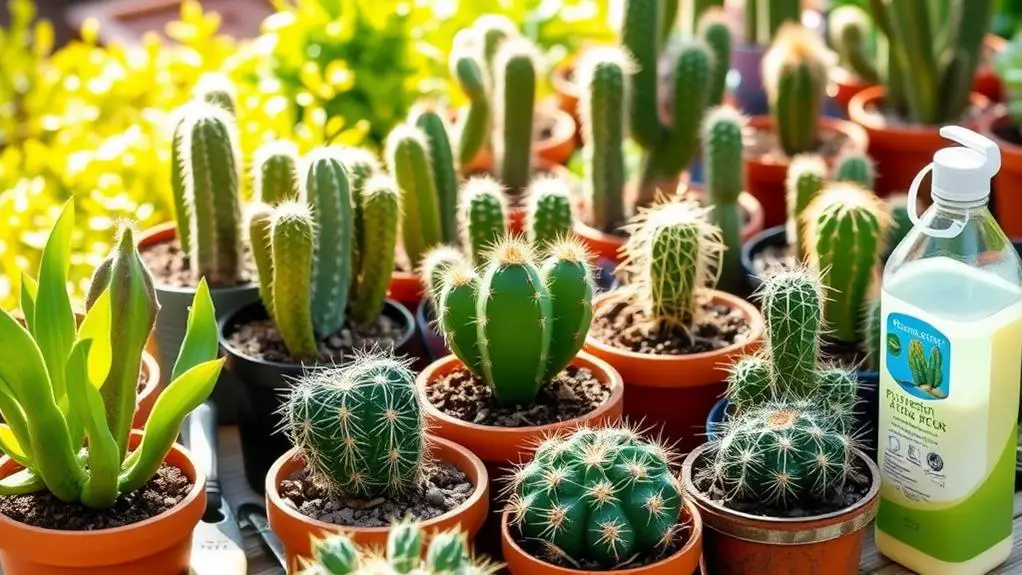
When it comes to fertilizing your cactus, it's all about choosing the right type and timing it correctly.
You'll want to use a low-nitrogen fertilizer with more phosphorus and potassium to help your cactus bloom and stay healthy.
Remember to fertilize during the growing season, typically in spring and summer, and always dilute the fertilizer to half strength to avoid burning the roots.
Choosing Proper Fertilizer
Selecting the right fertilizer is vital for the health and blooming potential of your cacti. You want your cactus to thrive and show off its beautiful flowers, right? Here are some tips to help you choose the best fertilizer and keep your cactus in top shape.
First, select a fertilizer specifically formulated for cacti. These are usually low in nitrogen but high in phosphorus and potassium, which are key for healthy tissue and blooming. Use it during the growing season, which is spring and summer, when your cactus is actively growing.
To guarantee your cactus doesn't get too much of a good thing, dilute the fertilizer to half strength before applying. This helps prevent root burn and makes certain the nutrients are just right for your plant. Organic options like compost can also be beneficial, enhancing soil quality naturally without the risks of synthetic fertilizers.
Remember, avoiding fertilizing during dormancy (fall and winter) is vital. Your cactus doesn't need extra nutrients when it's not growing.
Here are the steps to follow:
- Choose cactus-specific fertilizer.
- Apply during the growing season.
- Dilute to half strength.
- Consider organic options.
You've got this! Your cactus will thank you with vibrant, healthy growth.
Fertilization Timing Guidelines
To keep your cactus healthy and thriving, timing your fertilization is essential. Following proper fertilization timing guidelines can make a big difference. During the growing season, which is spring and summer, cacti benefit from low-nitrogen fertilizers that are high in phosphorus and potassium. They're not heavy feeders, so you only need to fertilize them once in spring and once in summer.
When you fertilize, make certain to dilute the fertilizer to half strength. Apply it to damp soil after watering to prevent root burn. Remember, new cacti may not need fertilizing for the first 1-2 years, allowing them to acclimate.
Here's a handy table to help you remember these tips:
| Season | Fertilization Tips |
|---|---|
| Spring | Use a low-nitrogen fertilizer, high in phosphorus and potassium, diluted to half strength. |
| Summer | Repeat spring's fertilization process. |
| Fall | Avoid fertilizing due to the dormancy period. |
| Winter | Skip fertilization entirely during dormancy. |
Avoid fertilizing during the dormancy period in fall and winter, as cacti don't need extra nutrients then. By following these guidelines, you'll guarantee your cactus gets just the right amount of nutrients to grow strong and vibrant.
Repotting Guidelines
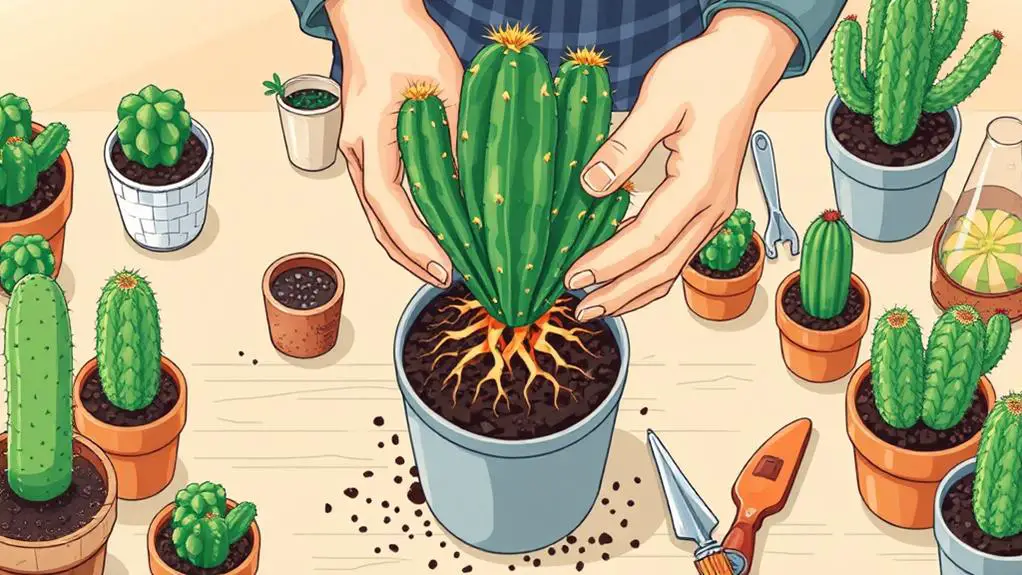
Repotting your cactus every 2-3 years or when it becomes root-bound is essential for maintaining its health. This keeps the plant thriving and prevents issues like root rot.
Follow these repotting guidelines to keep your cactus happy and growing:
- Choose the right pot: Always use a pot with drainage holes. This prevents water from sitting at the bottom, which can lead to root rot.
- Use fresh cactus soil mix: Cacti need well-draining soil. A mix with sand and perlite works best, allowing excess water to escape easily.
- Repot during the growing season: Spring or early summer is ideal. Your cactus will recover faster and continue to grow healthily.
- Watering after repotting: Let your cactus dry out for about a week before watering. This gives the roots time to heal and reduces the risk of rot.
Pruning Techniques
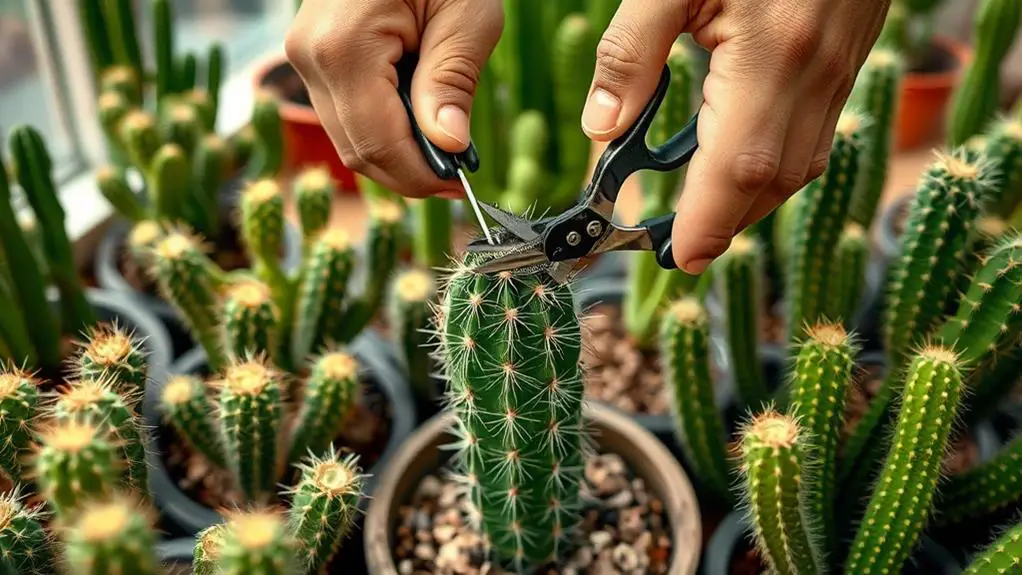
Pruning your cactus is an important part of its care routine, especially when it's time to encourage healthy growth and remove dead or unhealthy segments. Start by selecting the right time, ideally during the cactus's dormancy period. This minimizes stress and helps your cactus bounce back stronger.
Before you begin, gather your tools. Use sharp, sterile tools to guarantee clean cuts, which prevent disease and promote faster healing. Remember, clean cuts are essential for the plant's health. Wear protective gear like gloves and long sleeves to avoid injury from sharp spines. Safety first!
For taller cacti, think of pruning as you'd with trees. Trim away any dead or unhealthy segments, making sure to cut just above the healthy part. This encourages new growth and a healthier plant overall.
After pruning, don't rush to replant. Let the cut ends callus for a few days. This step is critical as it reduces the risk of rot, giving your cactus the best chance to thrive.
Pruning techniques might seem intimidating at first, but with these tips, you'll gain confidence in caring for your prickly plants. Your cactus will thank you with vibrant, healthy growth.
Propagation Methods
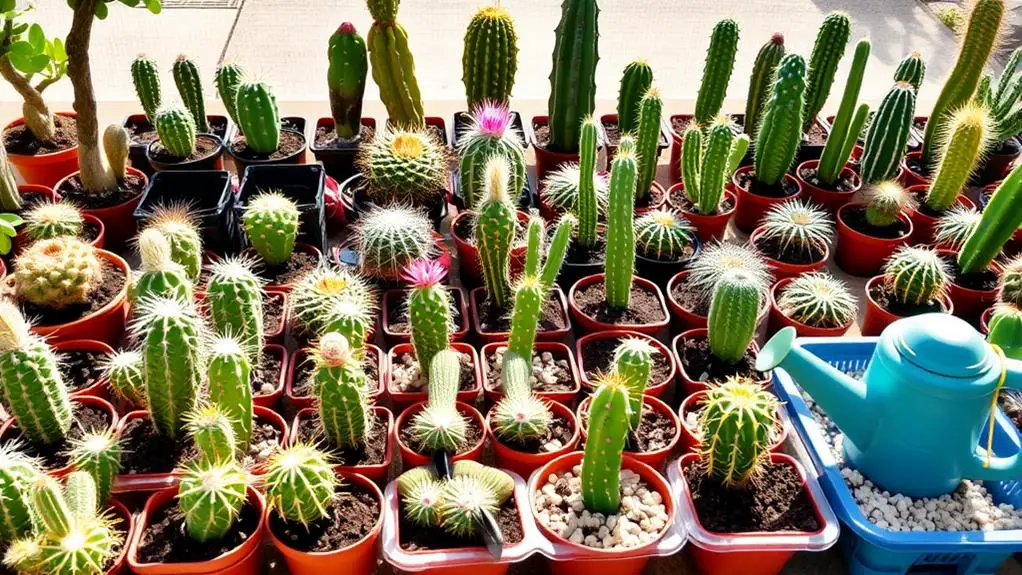
When it comes to propagating cacti, you'll find that using stem cuttings is a quick and straightforward method. This technique is popular because it's easy and yields fast results.
To get started, simply cut a healthy piece of the cactus and let the cut end callus over for a few days. This step is essential to prevent rot when you plant it in well-draining cactus soil.
Here's what you should do:
- Cut a piece: Use a clean, sharp knife to take a stem cutting from your cactus.
- Let it callus: Leave the cut end to dry and form a callus for several days.
- Plant the cutting: Place the callused end into well-draining cactus soil.
- Wait patiently: It can take several weeks to months for roots to establish.
Another effective propagation method involves using offsets, which are small offshoots that some cactus species naturally produce.
Carefully separate these offsets from the parent plant and plant them in well-draining soil. Just like with stem cuttings, you'll need patience as they grow.
Temperature Requirements
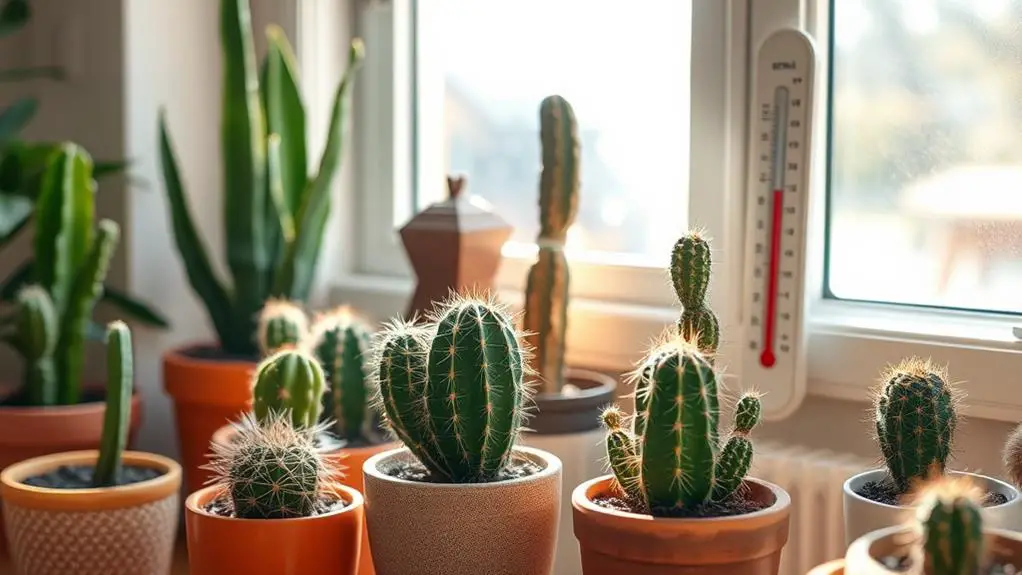
Maintaining the right temperature is vital for the health and growth of your cactus. Most cacti thrive in warm environments with temperatures between 70°F and 100°F. This range is perfect for their growth and overall well-being.
If you live in a cooler climate, don't worry too much—some cactus species can handle temperatures as low as 50°F. However, you should avoid prolonged exposure to cold, as it can cause stress or even damage your cactus.
Sudden temperature changes can also be harmful. Try to keep your cactus in a stable environment to prevent stress. During winter months, it's especially important to provide protection from frost. Frost can be deadly to cacti, so consider bringing your plants indoors or using a frost cloth if you expect freezing temperatures.
Additionally, maintaining low humidity levels is essential. Cacti are used to desert conditions, so they thrive in dry air. High humidity can lead to health problems, including rot.
To mimic their natural habitat, place your cactus in a well-ventilated area with plenty of sunlight. Following these temperature requirements will help guarantee your cactus stays healthy and happy year-round.
Signs of Overwatering
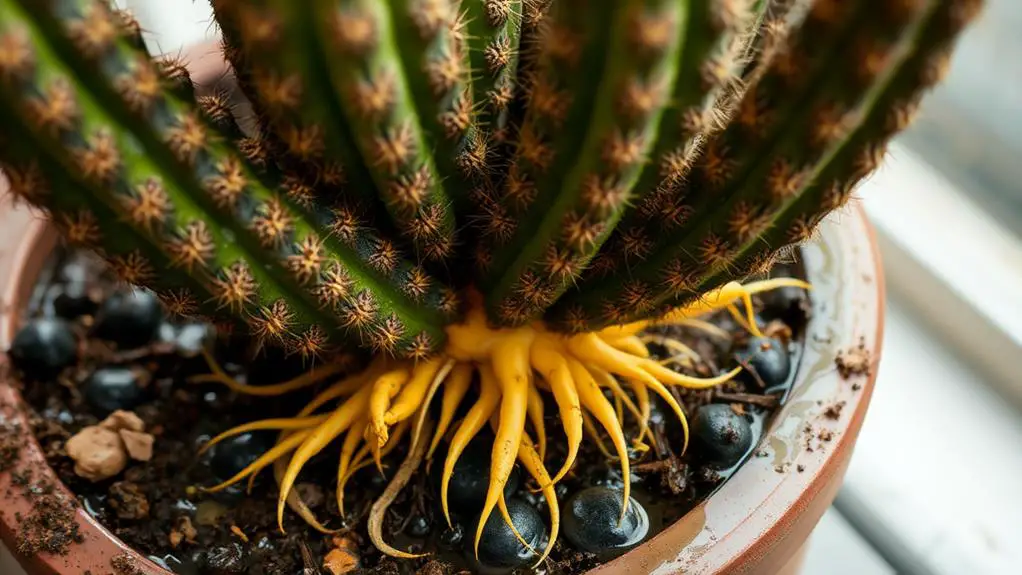
Overwatering is a common pitfall that can wreak havoc on your cactus.
It's important to recognize the signs of overwatering to prevent damage and promote a healthy plant.
Here's what to look for:
- Soft, mushy stems: This often indicates root rot, a severe condition caused by excess water.
- Brown or yellow discoloration: These changes on the plant's surface are signals that your cactus is stressed.
- Scabs or lesions: These can develop on stems as a reaction to too much moisture.
- Foul odor from the soil: A bad smell is a clear sign of root rot, typically due to overwatering.
Cacti thrive in well-draining soil and need the top 2-3 inches to be completely dry before you water them again.
If you notice any of these signs, your cactus might be getting too much water.
Overwatered cacti may also drop leaves or pads, showing further signs of stress.
Don't worry, though. You can fix this!
Let the soil dry out completely, and make sure you're using a well-draining soil mix.
With a bit of attention, your cactus will bounce back and continue to grow beautifully.
Frequently Asked Questions
What Are 5 Interesting Facts About Cactus?
You'll find cacti fascinating because they store water in fleshy stems, use spines instead of leaves, can live over 150 years, reach up to 60 feet, and bloom vibrantly to attract pollinators. They're true survivors!
What Does an Overwatered Cactus Look Like?
An overwatered cactus looks soft and mushy with brown spots, yellowing at the base, and may ooze plant material. Wrinkles near the base can also appear due to the plant's inability to absorb water from saturated soil.
How to Tell if a Cactus Is Healthy?
To tell if a cactus is healthy, check for firm, plump stems and vibrant colors. Look for intact spines and signs of new growth. Verify it's in well-draining soil, gets adequate sunlight, and is watered properly.
Should I Spray My Cactus With Water?
You shouldn't spray your cactus with water. Cacti prefer dry conditions, and spraying can lead to rot and disease. Instead, water the soil directly when it's completely dry. Use a humidity tray if needed for air moisture.
Conclusion
Taking care of your cactus doesn't have to be tricky. Remember to let the soil dry before watering, provide plenty of sunlight, and use well-draining soil. Keep an eye out for pests, and don't forget to fertilize and prune when needed. With the right temperature and humidity, your cactus will thrive. Follow these tips, and you'll become a confident cactus caretaker in no time. Enjoy watching your cactus grow strong and healthy!

